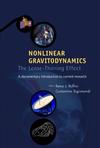非线性重力动力学
2003-12
World Scientific Pub Co Inc
Sigismondi, Costantino 编
509
This book gives a detailed, up-to-date account of the Lense–Thirring effect and its implications for physics and astrophysics. Starting from a profound intuition of Lense and Thirring in 1918, based on a simple solution to the linearized Einstein field equations, this has emerged in the past four decades as a phenomenon of extraordinary importance in cosmology, radio jets in quasars, and the physics of neutron stars and black holes, besides leading to some of the most sophisticated experiments ever performed in the space surrounding our planet. The book contains the contributions presented at the "Third William Fairbank Meeting", which have been expanded by adding a complete set of classical and prominent contemporary papers on this subject and a general introduction by R Ruffini.
ForewordThe Contributions to the WFM3 and INWlIntroduction to Nonlinear Gravitodynamics: The Lense-Thirring EffectSection A: Equations of Motion of Spinning Particles in Electrodynamics and General Relativity Some considerations on the varieties of frame dragging Equations of Motion of Spinning Relativistic Particle in External Fields Equations with Intrinsic Rotation in Gravitational Theory Spinning Particles in the Kerr Field Energy First Integral for Spinning Particles in the Schwarzschild Background Nongeodesic Motion of Charged Spinning Test ParticlesSection B: Inertial Forces and Gravitoelectromagnetism Absolute and Relative Frenet-Serret Frames for Accelerated Black Hole Circular Orbits Centripetal Acceleration and Centrifugal Force in General Relativity On the (Non)Existence of a Gravitomagnetic Dynamo Rotation of the Polarization Plane in the Gravitational Field of Rotating ObjectsSection C: The GP-B Mission: The Orbiting Gyroscope Experiment around the Earth General Treatment of Geodetic and Lense-Thirring Effects on an Orbiting Gyroscope Classical Torque Errors in Gravity Probe B Experiment Data Reduction in the Gravity Probe B Experiment: Optimal Estimation and FilteringSection D: Probing the Lense-Thirring Effect around the Earth with Twin Satellites The Gravitomagnetic Field and its Measurement with the Lageos Satellites Lense-Thirring Precession Determination from Laser Ranging to Artificial Satellites On Gravitomagnetic and Rotational Analogue of the Hall Effect: A Possibility to Detect Lense-Thirring Field of EarthSection E: Probing the Gravitomagnetic Lense-Thirring effect with Neutron Stars and Black HolesClassical PapersContemporary Papers
